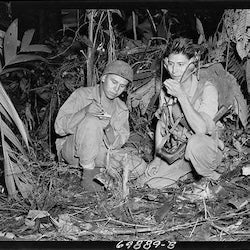
Honoring Navajo Code Talkers Day: Language, Courage, and Teaching the Next Generation
Share

Every August 14, Navajo Code Talkers Day offers us—especially those of us working to teach Diné bizaad— a moment to reflect on the power of our language and the courage of those who used it to protect a nation. The Code Talkers remind us that language is not just a means of communication, but a living tool of survival, resilience, and cultural strength.
During World War II, young Navajo Marines developed an unbreakable code based on Diné bizaad. At a time when military codes could be intercepted, their messages traveled securely and swiftly—often in less than 20 seconds—ensuring military strategies remained safe. The Japanese military never broke the code. This was possible because of the complexity, structure, and beauty of the Navajo language, and the Code Talkers’ skill in applying it to new, urgent purposes.
A Language Once Punished, Then Celebrated
For many of these young men, the war years marked a striking reversal. They had grown up in an era when speaking Navajo in school was discouraged or punished. Yet the U.S. military came to depend on their fluency. This history holds a powerful message for our classrooms: languages that are devalued by dominant systems can still be indispensable in moments of crisis and change.
After the war, their achievements remained classified for decades. Many returned to their communities without public recognition. It wasn’t until 1982 that President Ronald Reagan proclaimed August 14 as Navajo Code Talkers Day, and not until 2001 that they received the Congressional Gold Medal.
Lessons for the Classroom
For Navajo language teachers, this day is more than a historical commemoration—it is a teaching opportunity. The Code Talkers’ story can:
- Affirm the value of Navajo in modern and global contexts.
- Inspire students by showing how traditional knowledge adapts to meet contemporary challenges.
- Highlight fluency as a form of power, especially when paired with quick thinking and teamwork.
- Encourage pride in speaking, reading, and writing Diné bizaad.
Students who learn about the Code Talkers often ask why the language was so effective as a code. That question opens the door to teach about the unique phonology, verb structure, and descriptive richness of Navajo— and how these linguistic features resisted enemy decoding.
Five Children’s Books to Support Classroom Learning
- Chester Nez and the Unbreakable Code by Joseph Bruchac
- Code Talker: A Novel About the Navajo Marines of World War Two by Joseph Bruchac
- The Unbreakable Code by Sara Hoagland Hunter
- Navajo Code Talkers (We the People series) by Andrew Santella
- Warriors: Navajo Code Talkers by Kenji Kawano
On this day, let’s honor the Code Talkers not only for their bravery, but for reminding the world of the power of Diné bizaad. In our classrooms, we carry forward that legacy—ensuring that the language they used to help win a war remains strong, vibrant, and alive for generations to come.
Lesson Plan Companion: Teaching Navajo Code Talkers Day
Grade Level: 4th–12th (adaptable)
Subject Areas: Navajo Language, Navajo History, Social Studies, Language Arts
Time Frame: 1–2 class periods (45–90 minutes)
Learning Objectives
- Describe who the Navajo Code Talkers were and explain why they are important to Navajo and U.S. history.
- Identify key linguistic features of Diné bizaad that made it effective as a wartime code.
- Use new Navajo vocabulary related to war, communication, and honor.
- Connect the Code Talkers’ story to the importance of preserving and speaking Navajo today.
Key Navajo Vocabulary
- Diné bizaad – Navajo language
- naaltsoos bá hooghan – code/message
- naaltsoos – paper/document
- hane’ – story/history
- hózhó – balance/beauty/harmony
- ts’ídá – soldier
- baa hane’ – biography/story about someone
- da’iináanii – bravery/courage
Discussion Questions
- Who were the Navajo Code Talkers, and why was their work important?
- How did speaking Diné bizaad help during the war?
- Why is it powerful that the Code Talkers used a language that had once been punished in schools?
- How does learning Navajo today keep the Code Talkers’ legacy alive?
- If you were creating a new code today, what words or ideas from Navajo would you use?
Activities
- Story & Language Connection (20–30 min): Read excerpts from a Code Talker book, highlight Navajo words, and have students create coded messages.
- History Map Activity (15 min): Show a WWII Pacific map, discuss Code Talker movements, and use Navajo place descriptions.
- Vocabulary & Context (15–20 min): Introduce vocabulary and have students write sentences about the Code Talkers.
- Oral History Reflection: Students interview family or elders about language use and connect it to the Code Talkers’ legacy.
Assessment Ideas
- Formative: Participation, vocabulary accuracy, engagement.
- Summative: Oral or written presentation in Navajo and English about the Code Talkers and language preservation.
Extension for Language Teachers
- Play actual Code Talker recordings and have students identify words.
- Create a bilingual classroom display with student work for August 14.
